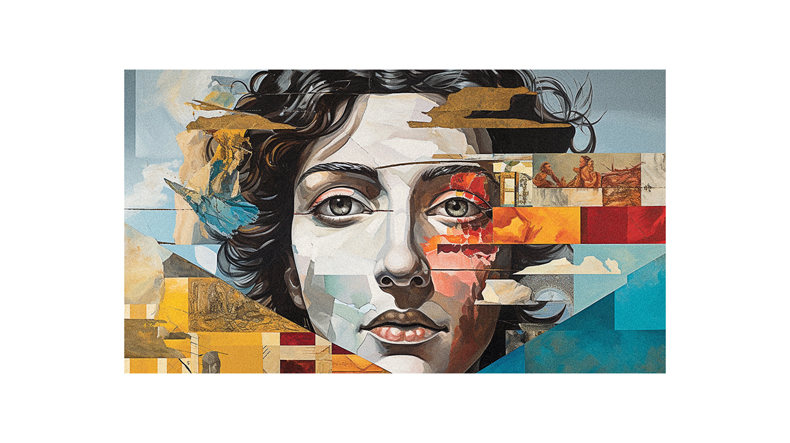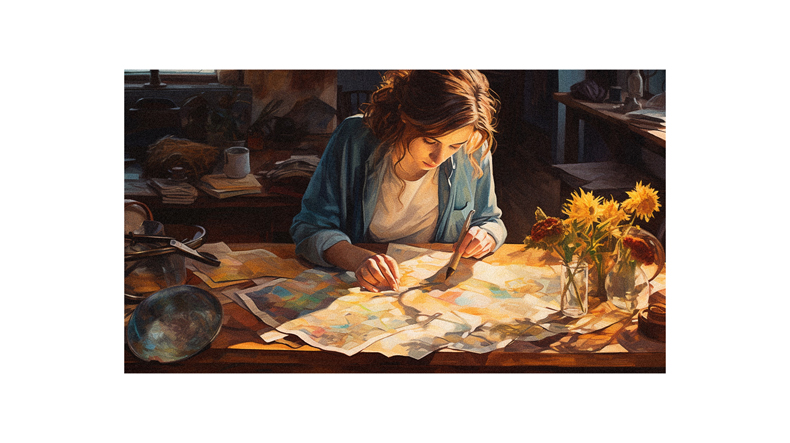Just as a detective unravels the mysteries of a crime scene, you, too, can dive into the intriguing world of art criticism. This is your chance to dissect an artwork, peeling back its layers to reveal hidden depths and meanings.
Art criticism isn’t just for scholars or critics; it’s for anyone willing to look beyond the surface of an art piece. It involves four key steps: description, analysis, interpretation, and evaluation.
You’ll start by describing what you see in front of you—the colors, shapes, and lines—and gradually delve deeper into the principles that make up the artwork. You’ll interpret its meaning based on these elements and your connection with it.
Finally, you’ll evaluate its worth. Remember that this isn’t about passing judgment but understanding and appreciating art more deeply.
So prepare yourself for a journey that will enrich your perspective on art!
What is it?

At its core, art criticism is a rich and enlightening conversation about visual art. It involves a thoughtful evaluation and discussion of the artwork’s elements, principles, meaning, and impact. It’s not just about saying if you like or dislike an artwork. Instead, it requires you to engage deeply with the work. You need to describe what you see, analyze how the artist has used various elements like color or line, interpret what it could mean based on your analysis, and evaluate its overall success.
You’re essentially becoming part of a dialogue that extends beyond yourself. This dialogue includes the artist’s intentions and the viewers’ diverse perspectives. This process can enrich your understanding of art while honing your critical thinking skills.
Steps of Art Critique
Let’s cut to the chase, darling; critiquing a masterpiece isn’t exactly akin to judging your neighbor’s questionable choice of lawn gnomes; it has more depth and finesse. It involves four essential steps:
- Description: Start by painting a vivid picture of the artwork with words. Describe its colors, shapes, textures – every tiny detail that catches your eye.
- Analysis: Look closely at how the artist weaves elements like line and color to convey a certain mood or message.
- Interpretation: Interpret what you think the artist intended to communicate through their work.
- Evaluation: Lastly, evaluate – this is where you express your opinions on whether the art successfully achieved its purpose.
Describe
Diving straight into the first step, description, you’re tasked with capturing the artwork’s essence through your lens. This means describing the piece so that anyone who hasn’t seen it can visualize it.
Start by stating the obvious – the work’s title, artist’s name, medium used, and year created.
Then, give a detailed account of what is in front of you – colors used, shapes spotted, subjects portrayed, and any noticeable techniques applied. It may seem like a simple observation, but remember that your role here is to be an ‘eye’ for those not present at this viewing.
Your words should paint a picture as vivid as possible to set a solid foundation for further steps in art criticism.
Analyze
After you’ve painted a vivid picture through description, it’s time to dig deeper into the piece with analysis. This part of your critique asks you to dissect the artwork into its elemental parts – line, color, rhythm, harmony, and variety.
Look closely at how the artist has used these elements and ask yourself what impact they have on the overall work. Does a bold use of color evoke certain emotions? Do distinctive lines direct your gaze in a particular way? Is there an exciting interplay between different shapes or textures?
Analyzing these details helps you understand the artist’s technical skills and gives insight into their creative process. Remember to take your time; good analysis requires careful observation and thought.
Interpret
Next up, you’re tasked with interpreting the artwork in question. This stage requires a shift from objective analysis to subjective interpretation. Consider what the artist might be trying to communicate through their work. What emotions or themes do you perceive? How does the artwork relate to your own experiences or worldview?
It’s also crucial to remember that there isn’t always a definitive ‘right’ interpretation—art is inherently subjective, and different viewers may draw different conclusions. Engage deeply with the piece and consider its impact on you. The trick here is to view and feel the art, allowing it to resonate within you before drawing any conclusions.
Remember, your interpretation is unique and valid as long as it’s supported by thoughtful insight.
Evaluate
So, you’ve made it to the grand finale of your critique journey – evaluation. Now’s the time to don your judgmental hat and dish out some cold, hard truths about the piece. Is it a masterpiece that could bring tears to a stone statue, or is it more akin to something your toddler nephew scribbled during nap time? Remember, this is where you’re allowed to let your personal biases frolic freely – if you think the painting looks like a catastrophic color collision, say so!
But remember: as much as we love our opinions, they should be backed up by solid reasoning. No throwing senseless shade here! Ask yourself: What’s its worth? Does it make an impact, or does it leave you indifferent?
Elements of Art
After thoroughly evaluating the artwork, you might wonder what’s next. It’s time to delve deeper into the ‘Elements of Art’.
These elements are vital details that build up an art piece, including line, shape, form, value, color, texture, and space. They’re like the DNA of an artwork; without them, a piece can’t exist!
When observing a work of art closely, try to notice how these elements combine to create a cohesive whole. Look at how lines move your eye around the painting or how colors evoke certain emotions.
By understanding these fundamental components in every artwork you critique, you’ll develop a solid base for your criticism and gain better insights into an artist’s intention.
Lines
Imagine a painting without lines – it’s nearly impossible. Lines are the basic building blocks of any visual art form. They provide structure, define shapes, and guide your eyes through an artwork.
As you critique art, pay close attention to how artists use lines. Are they straight or curved? Bold or faint? Do they follow a particular direction? These choices can convey emotion, suggest movement, and create depth in the piece.
Also, consider line variation. Different thicknesses or types of lines (like dotted or dashed) can evoke different feelings. A powerful artwork often employs diverse line techniques to capture viewers’ interest and communicate its message effectively.
Remember, understanding lines is your first step towards insightful art criticism.
Value
Dive deeper into the artwork’s narrative by exploring its use of value. Value in art refers to the lightness or darkness of colors. It’s a significant factor in creating an illusion of form and depth, making your subject appear three-dimensional on a flat surface.
Examine how the artist uses contrasting values to emphasize certain areas within their piece. Does the artwork have a wide range of values, from very dark to extremely light? Or does it limit itself to a narrow spectrum? Notice how these choices affect the mood and focus of the work.
Remember, there’s no right or wrong here – just different artistic decisions leading to unique effects. With each critique, you’ll gain insight into this vital element and enhance your understanding of art.
Tone
Having explored the importance of value in art critique, let’s now shift our focus to ‘Tone.’
The tone is a critical aspect to consider while critiquing artwork. It refers to the overall mood or atmosphere that the painting creates. This is conveyed through elements like color, lighting, and composition.
As you delve deeper into understanding an art piece, note how it makes you feel. Does it evoke a sense of calmness or induce anxiety? Perhaps it stirs up feelings of joy or melancholy? The tone set by the artist often guides these emotional responses.
Recognizing and articulating this can enrich your critique significantly as it shows your emotional engagement with the artwork.
Follow us on Pinterest for more tips, tutorials, and artist reviews!





